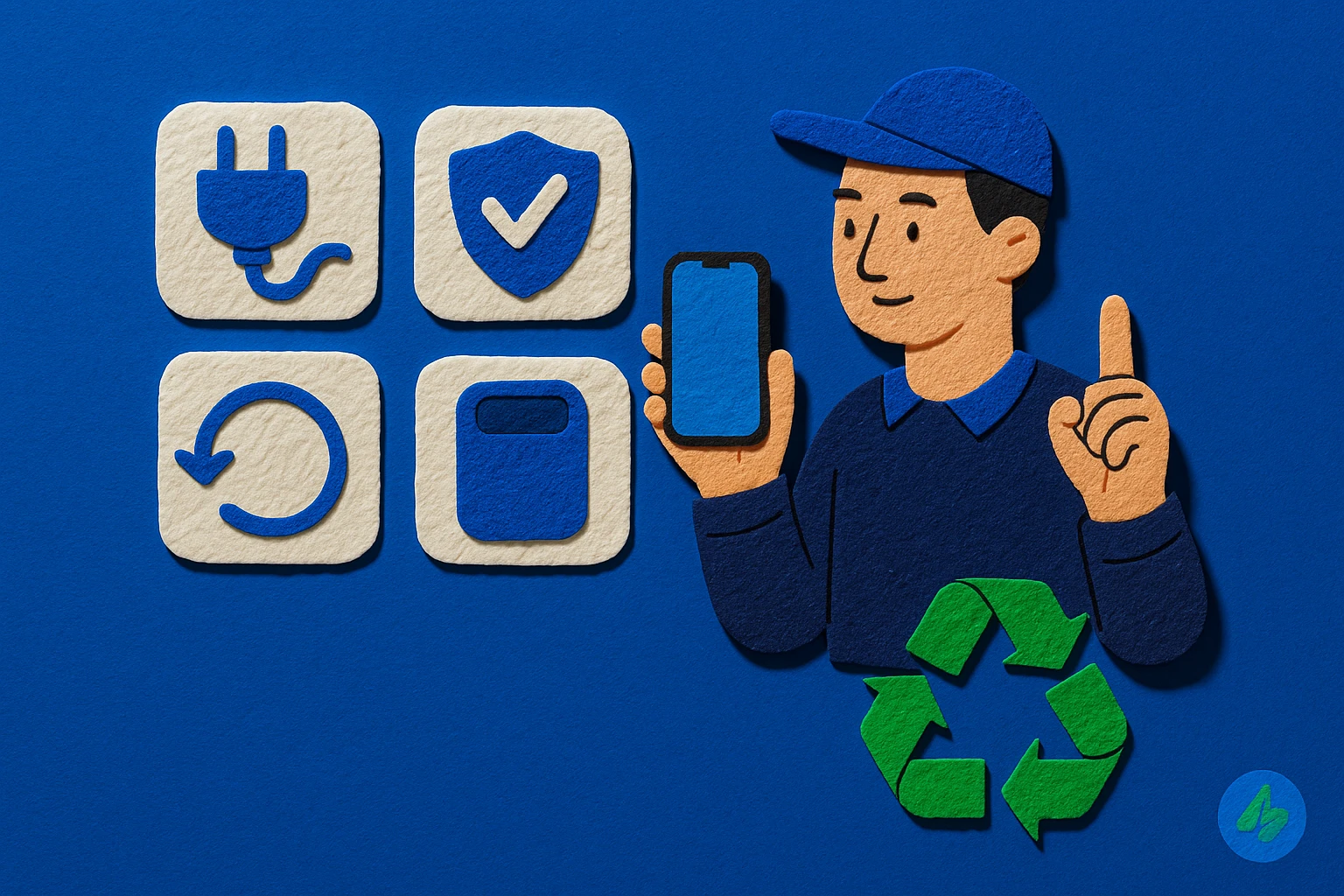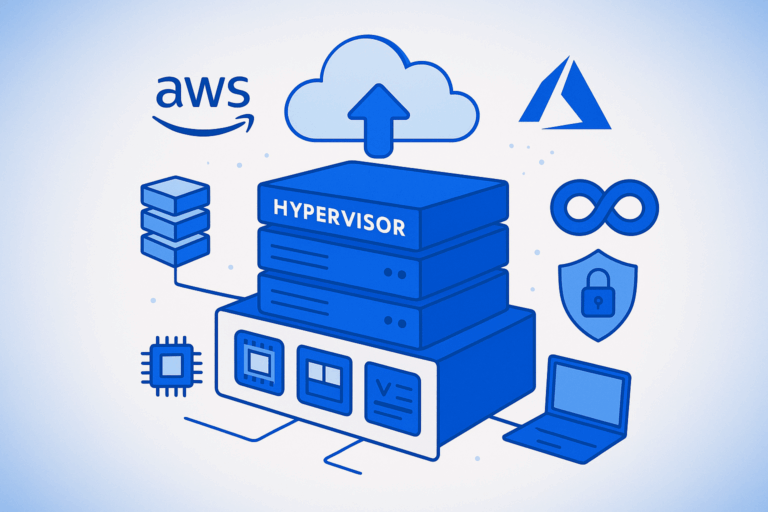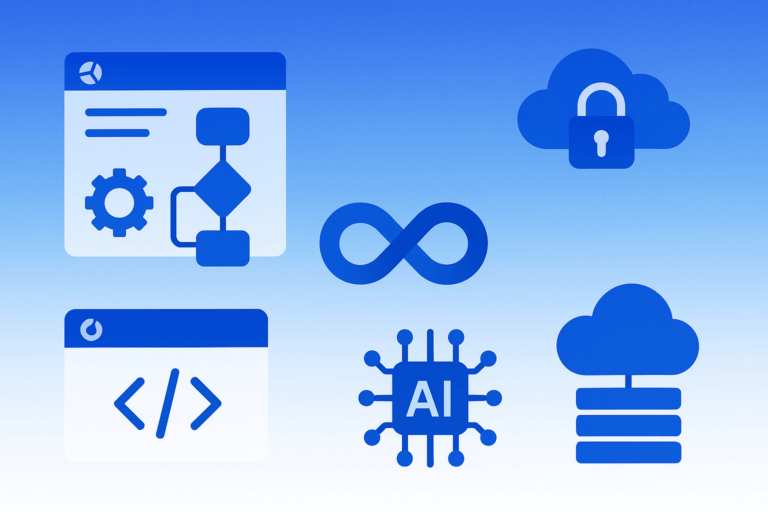Simple Tips to Extend Your Phone’s Life and Reduce E-Waste

A Tech Professional’s Guide 📱♻️
Introduction
As IT professionals and software development companies increasingly focus on sustainable technology practices, extending phone life has become crucial for reducing e-waste and optimizing operational costs.
Modern smartphones contain valuable resources and sophisticated engineering. Yet most devices are replaced within 2-3 years, contributing to the growing e-waste crisis.
This comprehensive guide provides actionable strategies for IT professionals to maximize device longevity while supporting environmental sustainability.

Understanding E-Waste Impact in IT Infrastructure 🌍
The Scale of the Problem
Electronic waste represents one of the fastest-growing waste streams globally. In 2023, approximately 5.3 billion phones were discarded worldwide.
For IT departments managing hundreds or thousands of devices, this creates significant environmental and financial implications.
Why Phone Longevity Matters for Tech Teams
Environmental Benefits:
- Reduced mining of rare earth elements
- Lower carbon footprint from manufacturing
- Decreased toxic waste in landfills
Business Benefits:
- Reduced procurement costs
- Extended ROI on technology investments
- Improved corporate sustainability metrics
Essential Hardware Maintenance Strategies 🔧
Battery Optimization Techniques
Battery degradation is the primary reason for device replacement. Proper management extends usable life significantly.
Best Practices:
- Maintain charge levels between 20-80%
- Avoid overnight charging when possible
- Use original or certified charging accessories
- Enable battery optimization features
Temperature Management
Heat accelerates component degradation. IT professionals should implement thermal management protocols.
Temperature Control Methods:
- Remove cases during intensive tasks
- Avoid direct sunlight exposure
- Monitor CPU usage patterns
- Implement cooling periods during heavy usage
Physical Protection Protocols
Protection Strategy Table:
| Component | Risk Factor | Protection Method | Expected Lifespan Extension |
|---|---|---|---|
| Screen | Impact damage | Tempered glass protector | +40% |
| Body | Scratches/dents | Quality case | +35% |
| Ports | Debris/moisture | Port covers | +25% |
| Camera | Lens damage | Camera protector | +30% |
Software Optimization for Longevity 💻
Operating System Management
Regular OS updates provide security patches and performance improvements. However, selective updating prevents forced obsolescence.
Update Strategy:
- Install security patches immediately
- Research major OS updates before installation
- Maintain previous OS version compatibility
- Monitor performance impact post-update
Application Management Best Practices
Bloatware and unnecessary applications consume resources and reduce performance.
Optimization Checklist:
- Uninstall unused applications
- Disable background app refresh
- Clear cache regularly
- Monitor storage usage patterns
Performance Monitoring Scripts
For IT teams managing multiple devices, automated monitoring provides valuable insights.
#!/bin/bash
# Phone performance monitoring script
# Checks battery health, storage, and performance metrics
check_battery_health() {
echo "Checking battery health..."
# Battery health monitoring commands
adb shell dumpsys battery | grep level
adb shell dumpsys battery | grep health
}
monitor_storage() {
echo "Monitoring storage usage..."
adb shell df /data
adb shell du -sh /data/data
}
performance_check() {
echo "Performance metrics..."
adb shell top -n 1
adb shell cat /proc/meminfo
}
# Execute monitoring functions
check_battery_health
monitor_storage
performance_checkCloud-Based Device Management Solutions ☁️
Infrastructure as Code for Mobile Device Management
Modern IT environments benefit from treating mobile devices as infrastructure components. Terraform configurations can automate device policy deployment.
# Terraform configuration for mobile device management
resource "azurerm_mobile_device_management_policy" "phone_longevity" {
name = "extend-phone-life-policy"
resource_group_name = var.resource_group_name
settings {
battery_optimization = true
automatic_updates = "security_only"
app_restrictions = true
performance_monitoring = true
}
}
# AWS CloudFormation equivalent for device policies
resource "aws_iam_policy" "mobile_device_policy" {
name = "mobile-device-optimization"
description = "Policy for extending mobile device lifespan"
policy = jsonencode({
Version = "2012-10-17"
Statement = [
{
Effect = "Allow"
Action = [
"devicefarm:*",
"iot:*"
]
Resource = "*"
}
]
})
}Azure Cloud Integration for Device Analytics
Azure Cloud provides comprehensive device management capabilities through Microsoft Intune.
Implementation Benefits:
- Centralized device monitoring
- Automated policy enforcement
- Performance analytics
- Remote troubleshooting capabilities
AWS Cloud Mobile Device Management
AWS Cloud offers IoT Device Management services for enterprise mobile deployments.
Key Features:
- Device fleet management
- Over-the-air updates
- Security compliance monitoring
- Cost optimization analytics
DevOps Integration for Mobile Device Lifecycle 🔄
CI/CD Pipeline for Device Management
DevOps engineer teams can implement automated device management workflows.
# GitHub Actions workflow for device management
name: Mobile Device Lifecycle Management
on:
schedule:
- cron: '0 0 * * 0' # Weekly execution
jobs:
device_health_check:
runs-on: ubuntu-latest
steps:
- name: Checkout code
uses: actions/checkout@v2
- name: Run device diagnostics
run: |
./scripts/device_health_check.sh
./scripts/battery_analysis.py
./scripts/performance_report.py
- name: Generate maintenance report
run: |
python generate_maintenance_report.py
- name: Deploy optimization policies
run: |
terraform plan -var-file="device_policies.tfvars"
terraform apply -auto-approveMonitoring and Alerting Systems
Cloud Technology enables proactive device management through monitoring systems.
Alert Configuration:
- Battery health below 80%
- Storage usage above 85%
- Performance degradation detected
- Security patch availability
Advanced Optimization Techniques 🚀
Custom ROM and Firmware Management
For organizations with technical expertise, custom firmware provides enhanced control over device longevity.
Benefits:
- Removed bloatware
- Enhanced performance
- Extended security support
- Customized power management
Considerations:
- Warranty implications
- Security risks
- Support complexity
- Compliance requirements
Hardware Upgrade Strategies
Component Upgrade Feasibility:
| Component | Upgrade Difficulty | Cost Effectiveness | Lifespan Impact |
|---|---|---|---|
| Battery | Medium | High | +2-3 years |
| Storage | High | Medium | +1-2 years |
| RAM | Very High | Low | +0.5-1 year |
| Display | High | Medium | +1-2 years |
Predictive Maintenance Using AI
Machine learning models can predict device failure patterns and optimize maintenance schedules.
# Python script for predictive device maintenance
import pandas as pd
from sklearn.ensemble import RandomForestRegressor
import numpy as np
class DeviceLifespanPredictor:
def __init__(self):
self.model = RandomForestRegressor(n_estimators=100)
def prepare_features(self, device_data):
"""Prepare features for prediction model"""
features = pd.DataFrame({
'battery_cycles': device_data['battery_cycles'],
'average_temperature': device_data['avg_temp'],
'daily_usage_hours': device_data['usage_hours'],
'app_crashes': device_data['crashes'],
'storage_usage_percent': device_data['storage_pct']
})
return features
def predict_remaining_life(self, device_metrics):
"""Predict remaining device lifespan in months"""
features = self.prepare_features(device_metrics)
prediction = self.model.predict(features)
return max(0, prediction[0])
def generate_maintenance_schedule(self, devices):
"""Generate maintenance schedule for device fleet"""
schedule = []
for device in devices:
remaining_life = self.predict_remaining_life(device)
if remaining_life < 6: # Less than 6 months
schedule.append({
'device_id': device['id'],
'priority': 'High',
'action': 'Battery replacement recommended'
})
return schedule
Sustainable Disposal and Recycling Programs ♻️
Corporate E-Waste Management
IT departments should implement comprehensive e-waste management programs.
Program Components:
- Device inventory tracking
- Secure data wiping procedures
- Certified recycling partnerships
- Component recovery programs

Cost-Benefit Analysis for IT Organizations 💰
ROI Calculation Framework
Annual Cost Savings Calculation:
Total Annual Savings = (Device Replacement Cost × Devices Extended) - Implementation Cost
ROI = (Total Annual Savings / Implementation Cost) × 100Example Calculation:
- Organization: 1,000 devices
- Average replacement cost: $800
- Implementation cost: $50,000
- Devices extended by 1 year: 400
- Annual savings: $320,000
- ROI: 540%
TCO Optimization
Total Cost of Ownership Factors:
- Initial procurement costs
- Management and support expenses
- Security and compliance costs
- Disposal and recycling fees
- Productivity impact
Why choose Devolity
Unmatched Expertise in
Cloud and Cybersecurity
Devolity team of certified professionals brings decades of combined experience in managing complex cloud environments and defending against evolving cyber threats.
01
End-to-End Solutions for Every Business Need
DevOps with Cybersecurity Services: Hybrid/multi-cloud management, cost optimization, and DevOps integration with Risk assessments.
02
Customized Strategies, Not One-Size-Fits-All
We understand every business is unique. Devolity prioritizes collaboration, crafting bespoke solutions aligned with your industry, goals, and risk profile.
03
Proactive Protection with 24/7 Vigilance
Cyber threats never sleep—and neither do we. Devolity Security Operations Center (SOC) offers round-the-clock monitoring, rapid incident response.
Devolity Business Solutions: Optimizing Your Cloud Infrastructure 🏢
Devolity Business Solutions specializes in helping organizations optimize their Cloud Technology infrastructure while implementing sustainable IT practices.
Our expertise spans Terraform automation, Azure Cloud and AWS Cloud implementations, making us the ideal partner for DevOps engineer teams seeking to integrate mobile device management with cloud infrastructure.
Our Services Include:
- Infrastructure automation with Terraform
- Cloud-native device management solutions
- DevOps pipeline integration
- Cost optimization strategies
- Sustainability consulting
Contact us to learn how we can help your organization extend device lifecycles while optimizing cloud infrastructure costs.
Implementation Roadmap 🗺️
Phase 1: Assessment (Weeks 1-2)
- Inventory current device fleet
- Analyze replacement patterns
- Identify optimization opportunities
- Establish baseline metrics
Phase 2: Policy Development (Weeks 3-4)
- Create device management policies
- Implement monitoring systems
- Deploy optimization tools
- Train support teams
Phase 3: Automation (Weeks 5-8)
- Implement Terraform configurations
- Set up CI/CD pipelines
- Deploy cloud-based management
- Establish alert systems
Phase 4: Optimization (Ongoing)
- Monitor performance metrics
- Refine policies based on data
- Expand automation capabilities
- Measure ROI and sustainability impact
Measuring Success: KPIs and Metrics 📊
Key Performance Indicators
Device Longevity Metrics:
- Average device lifespan extension
- Battery health maintenance rates
- Performance degradation patterns
- User satisfaction scores
Environmental Impact Metrics:
- E-waste reduction percentage
- Carbon footprint reduction
- Resource consumption optimization
- Recycling program effectiveness
Financial Metrics:
- Cost per device per year
- Replacement cost savings
- Implementation ROI
- Total cost of ownership reduction
Future Trends and Considerations 🔮
Emerging Technologies
Right to Repair Legislation:
- Increased repair accessibility
- Standardized replacement parts
- Extended manufacturer support
- Enhanced documentation requirements
Sustainable Design Principles:
- Modular device architecture
- Recyclable materials integration
- Energy-efficient components
- Longevity-focused engineering
Industry Best Practices Evolution
Regulatory Compliance:
- Environmental regulations
- Data privacy requirements
- Security standards
- Sustainability reporting
Conclusion
Extending phone life and reducing e-waste requires a comprehensive approach combining technical expertise, automated management, and organizational commitment.
For IT professionals and software development companies, implementing these strategies provides both environmental benefits and significant cost savings.
The integration of Cloud Technology, Terraform automation, and DevOps practices creates a scalable framework for sustainable device management.
Success requires ongoing monitoring, continuous optimization, and stakeholder engagement across the organization.
By implementing these practices, IT teams can significantly extend device lifecycles while supporting broader sustainability goals.
Transform Business with Cloud
Devolity simplifies state management with automation, strong security, and detailed auditing.

Useful Resources and Links 🔗
External Resources:
- EPA Electronics Recycling Guidelines
- GSMA Mobile Industry Environmental Guidelines
- Terraform Documentation
- Azure Mobile Device Management
- AWS IoT Device Management
Related Articles:
- “Implementing Sustainable IT Practices in Enterprise Environments”
- “Cloud-Based Device Management: Best Practices for DevOps Teams”
- “Cost Optimization Strategies for IT Infrastructure”
- “Environmental Compliance in Technology Organizations”






